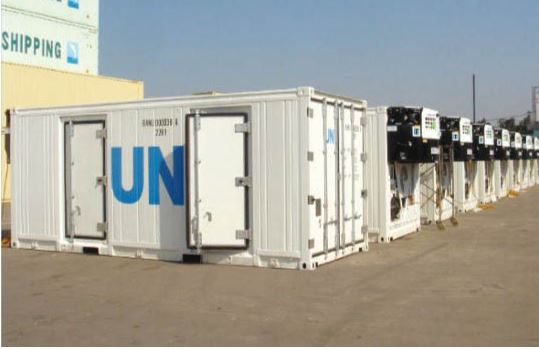Comprehensive Guide to Prefab Cold Storage Containers: Temperature-Controlled Storage Solutions
Prefab cold storage containers provide a flexible, efficient, and user-friendly solution for temperature-controlled storage needs. These containers are ideal for industries like food production, pharmaceuticals, and biotechnology, where maintaining precise temperatures is essential. With a temperature range of -40°C to +30°C, they are suited for various cold chain requirements, from the storage of fresh produce to the transport of sensitive medical supplies.
What is a Prefab Cold Storage Container?
A prefab cold storage container is a portable, temperature-regulated container that serves as a refrigeration unit for storing and transporting goods. Unlike standard ISO shipping containers, which are designed for basic cargo transport, prefab cold storage containers are purpose-built to handle products that require controlled temperatures. They come equipped with specialized features like reinforced doors, internal lighting, alarms, and escape hatches, which enhance safety, usability, and functionality.
Key Features of Prefab Cold Storage Containers
- Wide Temperature Range
Prefab cold storage containers can maintain temperatures between -40°C and +30°C, catering to various industry needs from ultra-cold storage for pharmaceuticals to standard refrigeration for food products. - Enhanced Door Design
Unlike typical ISO containers, these containers feature doors designed for frequent access. Some models offer both small and large door options, making them user-friendly for high-frequency operations. - Optional Features
Optional features include internal lighting, alarms, and escape hatches, which are especially beneficial for safety and operational convenience. These enhancements allow for safer access and monitoring, especially in low-light environments or during emergency situations. - Modular and Scalable
Prefab cold storage containers can be used as single units or combined to form larger storage areas. This flexibility enables businesses to scale their storage capacity without having to invest in permanent cold storage facilities.
Applications of Prefab Cold Storage Containers
Prefab cold storage containers are widely used across multiple industries:
- Food Industry: Ensures freshness for fruits, vegetables, meats, and dairy products throughout the supply chain, from farms to retail outlets.
- Pharmaceuticals and Life Sciences: Maintains required storage temperatures for vaccines, medications, and other sensitive materials, especially vital during medical emergencies and vaccine distribution.
- Biotechnology: Safely stores biological samples, laboratory reagents, and diagnostic kits that require strict temperature control.
- Import and Export Logistics: Provides reliable cold storage for high-value imports and exports, ensuring products arrive at their destination in optimal condition.
Types and Names of Cold Storage Containers
Prefab cold storage containers are known by various names, each reflecting a specific use or application:
- Container Cold Storage
- Prefab Cold Storage
- Portable Cold Storage
- Moving Cold Storage
- Refrigerated Cold Storage
- Vaccine Shipping Container
- Vaccine sea container manufacturer
Each term highlights the versatility and portability of these containers, emphasizing their role in safely storing and transporting perishable or temperature-sensitive items.
Advantages of Using Prefab Cold Storage Containers
- Efficient Temperature Control
With precise temperature settings, these containers can maintain stable internal conditions, safeguarding sensitive goods. Many models have adjustable controls, allowing them to adapt to different storage requirements seamlessly. - Mobility and Flexibility
Unlike fixed cold storage units, prefab containers can be transported to various locations, making them an ideal choice for temporary storage needs or mobile operations, such as seasonal crop storage or remote medical camps. - Scalable Storage Capacity
Individual containers can be combined to create larger storage spaces, allowing businesses to adjust their cold storage capacity based on demand, season, or growth without long-term infrastructure investments. - High Cargo Capacity
Cold storage containers can carry up to 30 tons of goods, with a maximum weight capacity of 34 tons. This high storage capacity makes them ideal for businesses that need to transport or store large volumes of goods securely. - Energy-Intensive Yet Reliable
Although cold storage containers have relatively high energy consumption, they operate continuously to ensure temperature stability, only pausing for scheduled defrost cycles. This reliability is crucial for industries where any temperature fluctuation could compromise product safety.
How Cold Storage Containers Support Cold Chain Logistics
Cold chain logistics depend on maintaining a continuous temperature-controlled environment for goods that are sensitive to temperature variations. Prefab cold storage containers play a vital role in this chain by providing a stable, controlled environment at various stages, from production to distribution. Key points in cold chain logistics include:
- Processing: Ensures that freshly harvested produce or manufactured pharmaceuticals remain fresh until they are packed and ready for transport.
- Transportation: Prefab cold storage containers are often used on trucks, ships, or airplanes, enabling seamless movement across regions or countries.
- Storage at Destination: Once the goods reach their destination, containers can serve as temporary storage units, ensuring product safety while waiting for distribution or sale.
Key Considerations When Using Cold Storage Containers
- Location and Power Source
Cold storage containers need a reliable power source for continuous operation. Consider the energy requirements and ensure there is sufficient infrastructure on-site, whether it’s for short-term or long-term usage. - Proper Loading and Unloading
Efficient loading is essential for temperature maintenance, as frequent door openings can lead to temperature fluctuations. It’s advisable to use standardized processes for fast, efficient loading and unloading. - Routine Maintenance
Regular maintenance, including defrosting, checking seals, and inspecting electrical components, is critical to ensuring consistent temperature control and preventing costly breakdowns. - Compliance with Safety Standards
Cold storage containers must adhere to industry regulations, especially for pharmaceuticals and food products. Ensuring compliance with health and safety standards helps avoid penalties and maintains product quality.
Frequently Asked Questions (FAQs)
Q1: How long can a prefab cold storage container maintain its temperature without power?
A: While prefab cold storage containers are highly efficient, they rely on constant power to maintain their temperature. Power outages may affect their performance, though high-quality insulation can help retain cool temperatures for several hours, depending on external conditions.
Q2: Are cold storage containers energy-efficient?
A: While they are designed to be reliable, cold storage containers consume a significant amount of energy to maintain low temperatures. Energy efficiency can be enhanced with features like LED lighting and optimized insulation.
Q3: Can cold storage containers be customized for specific temperature needs?
A: Yes, many prefab cold storage containers offer adjustable temperature settings and can be tailored to the needs of specific industries, whether ultra-low temperatures are required or standard refrigeration.
Q4: How do cold storage containers handle defrosting?
A: Cold storage containers have automated defrost cycles to prevent ice buildup, which is essential for maintaining cooling efficiency. During defrost cycles, the cooling system temporarily stops, but insulation helps retain a stable internal temperature.
Q5: Are prefab cold storage containers safe for human access?
A: Yes, most containers are designed with safety features, including internal lighting, alarms, and escape hatches, to ensure safe access for personnel during loading or maintenance.
Conclusion
Prefab cold storage containers are an indispensable asset for industries requiring precise temperature control. Their portability, scalability, and advanced features make them ideal for cold chain logistics, storage, and transportation of sensitive goods. By providing reliable, secure, and adaptable storage solutions, these containers are transforming the way industries manage temperature-sensitive products, from food and pharmaceuticals to biotechnology and beyond.




